
A gun cabinet is a vital component for any gun owner, providing secure storage and responsible firearm management. While commercially available options are readily available, crafting a personalized gun cabinet offers numerous benefits, including tailored dimensions, unique design elements, and cost savings. This guide outlines the process of building a secure and aesthetically pleasing gun cabinet, encompassing crucial considerations for secure compartment design and construction techniques.
1. Planning and Design:
a) Dimensions and Capacity:
Determine the number of firearms: Assess the total quantity and types of firearms to be stored.
Size of firearms: Measure the longest firearm to determine the minimum interior height of the cabinet.
Storage requirements: Consider additional items to be stored, such as ammunition, cleaning supplies, and accessories.
Space availability: Measure the designated area for the cabinet, taking into account wall thickness and any obstructions.
b) Design and Aesthetics:
Material choice: Select materials that meet the desired aesthetic and strength requirements. Popular options include hardwood, plywood, or metal.
Style and finish: Decide on the overall design aesthetic, including the cabinet's shape, door style, and desired finish. Consider elements like molding, decorative hardware, and paint or stain.
Functionality: Determine the desired number of compartments, shelves, and drawers for organized storage.
Security features: Prioritize security features like strong hinges, heavy-duty locks, and secure compartment design.
2. Material Selection and Preparation:
a) Cabinet Materials:
Hardwood: Offers durability, beauty, and natural resistance to moisture. Popular choices include oak, cherry, and maple.
Plywood: A cost-effective option with good strength and stability. Opt for marine-grade plywood for added moisture resistance.
Metal: Provides exceptional strength and fire resistance. Consider steel or aluminum for its durability and aesthetic qualities.
b) Compartment Materials:
Steel: Offers excellent strength and security, making it ideal for compartment walls.
Aluminum: Lighter than steel, yet still strong and resistant to corrosion.
Heavy-duty plywood: A cost-effective option that can be reinforced for added strength.
c) Preparation:
Cut and measure: Carefully cut materials according to the design specifications, ensuring precise measurements for a seamless fit.
Sanding and finishing: Smooth rough edges and imperfections with appropriate sandpaper. Finish materials with paint, stain, or varnish as desired.
3. Construction and Assembly:
a) Building the Cabinet Frame:
Jointing techniques: Employ robust jointing techniques like mortise-and-tenon joints, dovetail joints, or biscuit joints for a strong and durable cabinet frame.
Assembly: Carefully assemble the frame using wood glue, screws, and/or dowels for secure connections.
Reinforcement: Add additional support with bracing or battens to enhance structural integrity.
b) Compartment Construction:
Divider design: Create individual compartments within the cabinet using steel or aluminum sheets, heavy-duty plywood, or a combination of materials.
Secure attachment: Attach dividers to the cabinet frame using screws, rivets, or welding techniques, depending on the chosen materials.
Reinforcement: Reinforce compartments for added security with steel plates or heavy-duty hinges.
4. Door Construction and Secure Locking Mechanism:
a) Door Construction:
Material choice: Select hardwood, plywood, or metal depending on the desired aesthetics and security levels.
Design and style: Choose a door design that complements the cabinet's style, considering options like solid panels, raised panels, or glass panels.
Reinforcement: Add steel plates to the interior of the door for added security and strength.
b) Secure Locking Mechanism:
Lock type: Opt for high-quality locks with key-operated mechanisms or digital keypads for enhanced security.
Hardware: Choose strong hinges, secure hasps, and robust locking plates to resist tampering.
Placement: Position locks strategically for optimal protection against unauthorized access.
5. Finishing Touches and Safety Considerations:
a) Finishing Touches:
Paint or stain: Apply the desired finish to enhance the cabinet's appearance and protect the wood from moisture and scratches.
Hardware: Add decorative hardware like door handles, drawer pulls, and hinges that match the cabinet's style.
Interior organization: Install shelves, drawers, or other organizers to optimize storage and accessibility.
b) Safety Considerations:
Fire safety: Incorporate fire-resistant materials like metal or fire-rated plywood to protect firearms from heat damage.
Childproofing: Implement childproof locks or use a cabinet with secure latches to prevent unauthorized access.
Proper storage: Store firearms unloaded and with the action open, following all safety protocols.
6. Maintenance and Care:
Regular cleaning: Dust and clean the cabinet regularly to prevent dust accumulation and maintain its appearance.
Lock inspection: Regularly inspect locks for proper functioning and lubricate them as needed.
Material maintenance: Apply appropriate finishes or treatments to preserve the cabinet's materials and prevent damage.
Conclusion:
Building a secure and aesthetically pleasing gun cabinet requires careful planning, attention to detail, and the use of high-quality materials. By following this comprehensive guide, gun owners can create a personalized and functional storage solution that prioritizes both safety and security. Remember to prioritize secure compartments, robust locking mechanisms, and adherence to safety protocols for responsible firearm management. A well-constructed gun cabinet serves not only as a practical storage solution but also as a testament to a gun owner's commitment to responsible firearm ownership and safety.
0 comments:
Post a Comment
Note: Only a member of this blog may post a comment.